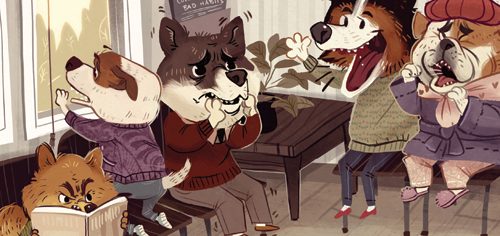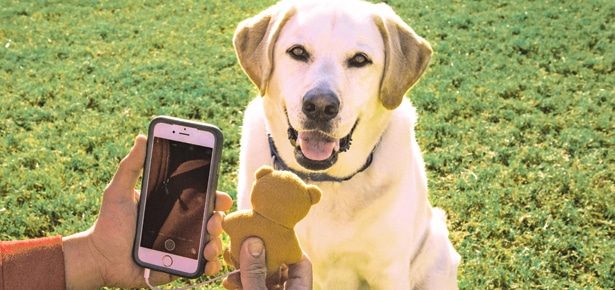

Rescue Me
Giving shelter dogs their best chance at success
Feist was an adorable ragamuffin of a dog, a little grey
and brown mop with bright eyes and a zesty personality.
For the Smith family, who were looking to adopt
a pet from their local shelter, it was instant love. Feist left the
shelter cradled in the arms of the five-year-old daughter, with
a brand-new life ahead of her. Ten days later, an upset Mr.
Smith dropped her off at the same shelter, reporting that Feist
had consistently peed in the house, she tore up clothes and furniture,
and the neighbours complained that she howled when
the family was out. The final straw came when she nipped the
daughter. Now, as a dog with documented behavioural problems,
Feist was not only back behind bars, she was close to
death row.
Although the particulars of this story are fictional, the situation
is not: fully one-fifth of all dogs adopted from shelters are
returned within a few months. Unfortunately, each “return”
stands a reduced chance of getting adopted out again, and often
becomes one of millions whose time simply runs out. According
to the Humane Society of the United States, an unwanted shelter
pet is euthanized about every eight seconds.
Why do shelter dogs get returned? Sometimes the reasons lie
with the new owner, who, though well-meaning, just isn’t cut
out for the responsibilities of dog ownership. Lack of time or
experience, or even expense can cause the most altruistic to reevaluate
and return. Many ill-fated adoptions are also the result
of an impulse acquisition by someone who might have ambled
by an adoption drive at the right (or wrong) time.
But, more often than not, it’s the dog who causes the trip
back to the shelter. Something about his behaviour or character
makes him incompatible with the perceptions and expectations
of the new owner. What seemed like an adorable, needy creature
at the shelter becomes a behavioural nightmare once in the
home. From there, it’s a quick trip back to the slammer.
The high return rate among shelter dogs points out some
problem that is not being properly addressed by shelters or by
well-meaning dog lovers. Generally, it boils down to an inability
of the interested parties to deal with the extent of trauma shelter
dogs go through in their struggle to survive.
Jailhouse Blues
Life for a dog making her way through the shelter system can
be a hellish experience. Many have been moved suddenly from
a stable family environment to a noisy, crowded shelter with
dozens of strange dogs who might or might not be friendly. To
a dog, the place is a chaotic collection of edgy strangers, some
amiable, others not so much. Alien smells, strange humans
moving about unpredictably: a foreign environment, with a disordered
routine. Like an inmate on her first day in lock-up, the
newcomer must survive and adapt, if possible. Fights, sleepless
nights, competition for food and space add up to a nervewracking
experience that can change a dog forever.
Dogs learn bad habits behind bars. Aggression can become the norm, particularly fear-based, territorial, and food aggression.
Though comfortable interacting with a reasonably sized
group of dogs, the typical canine becomes nervous surrounded
by scores of strangers; as such, her mindset can become one of
constant defense, resulting in a dog who, once adopted out, can
show hyper-vigilant behaviour and disdain for other dogs.
Shelter dogs learn to bark. A lot. It becomes the status quo in
most kennels; if everyone else is yelling and screaming, why
wouldn’t you? Unfortunately, this behaviour can
carry over to “civilian” life, making things
difficult for the new owners. Additionally,
a dog’s housetraining habits often fall
to pieces in a shelter kennel, where
other dogs eliminate randomly, and
where a sense of correctness no
longer exists. Coprophagy—the
consumption of feces—becomes
common, due to food competition
and boredom. Nervous chewing
and licking become an issue
as well.
Shelter dogs can contract infections
such as bordatella, coccidia, distemper,
or parvovirus, become infested
with fleas, ticks or worms, or contract
mange. Though shelter personnel strive to identify
and quarantine sick dogs, the truth is that, if a dog
is in a shelter, her former owner might not have been as timely
with vaccinations, raising the odds that a dog you adopt might
have contracted something.
All of these issues add up to one thing: rescue dogs suffer
disproportionately from physical and behavioural issues, resulting
in a high rate of return, and, ultimately, euthanasia. But if
potential good Samaritans arm themselves with an understanding
of the special needs of a secondhand dog, the odds of a
happy ending go up dramatically.
Choose the Right Dog
You can’t take them all, so choose a shelter dog that will best
fit into your lifestyle. If you prefer a sedate pet, for instance,
avoid sporting breed types and high-energy terriers, as they will
need activity often. Calmer breed-types such as Maltese or Toy
Spaniel mixes make more sense. Consider adopting an older
dog, who will be calmer than a puppy or adolescent. If you
want an active dog, look for a Lab or Pit mix, or a herding type.
Before choosing, ensure the dog is healthy. Watch for lameness,
or a poor coat. Pay attention to discharge from his eyes,
nose, ears, or genitals, and watch for excess panting. If possible,
look at his stool, which should be solid, with no worms
or blood present. Insist that vaccination records be provided
before you take any dog, and learn whatever you can about his
past life.
Observe the dog’s behaviour in and around the
kennel; look for a dog who is socially competent,
and not worried around other dogs. Avoid
cowering, hyper-vigilant, or barky dogs
with poor focus on you; a good shelter
dog should be relaxed and curious
when in your company.
Try to spend time with the dog
away from his kennel. Some shelters
will even let you try a dog out for
a few hours, in a place where you
can better see the dog’s real personality.
Watch him with other dogs
and people, and make sure he shows
no aggressive tendencies. If you have
another dog at home, ask the shelter if you
can bring him or her in to see if the two dogs
get along.
Set Up Your Home Ahead of Time
Before you bring the dog home, be sure your territory is secure.
Fix fence holes and ensure barriers are high enough to prevent
a jumper from escaping. If you suspect the dog is a digger,
place paving stones along the inner fence boundaries. Indoors,
secure windows and doors, and teach kids to always close
doors and gates. Remember, a rescue dog may want to escape
and find her old owner, so button her up!
Buy a plastic dog crate. Avoid wire crates, as they do not
afford a dog with the proper level of emotional refuge; to a
dog, being in a wire crate is like living in a fishbowl. Use this
to housetrain the dog and serve as a safe haven. Place the crate
in a quiet area, and have the dog sleep in it for at least the
first few weeks, to prevent accidents and destructive behaviour.
Remember, a rescue dog will be confused at first and not
dependable; best to ease her into the household while preventing
mistakes from ever happening. It’s also a good idea to feed the new dog in her crate to avoid food conflict with other pets.
Schedule a veterinary visit for the first week to ensure health
and get needed vaccinations. The relationship with your vet
will be one of your dog’s most crucial, so make it happen right
at the start.
Though you’ll want to feed your new companion the best
food possible, buy a small supply of whatever she was eating at
the shelter, then switch over to the preferred food over a twoweek
period. This will prevent diarrhea and help with the dog’s
psychological transition.
Establish a Routine
Help your rescue dog properly assimilate into your world by
establishing for him a structured routine.
Regimenting his day and not allowing
too much initial independence will help
prevent accidents, destructive behaviour,
separation anxiety, and escape. Set
a schedule. Get the dog out early each
morning, take him to the same spot to
eliminate, walk him, feed, train, and put
him to bed at the same times. Give the
dog something he can count on. Though
your aim will be to gradually give the
dog more and more independence, in the
beginning, keep a close eye on him and
never trust him off leash until he has been trained and in the
home for a few months.
Train!
Training should begin the moment the new dog arrives.
Manners, basic obedience, and socialization—key elements
missing from her life—should be integrated into her day.
Teaching her to sit, lie down, walk nicely on leash, come, and
stay will make your life easier, and help her focus. Teach tricks
and vocabulary, too, for fun, and to expand her repertoire of
behaviours, the key to intelligence.
Exercise and Enrich
Walks, runs, fetching—whatever you can do to get the dog
moving—will help him feel part of something special. Enrich
his world not only through exercise, but by teaching him tricks,
giving him safe toys and chews, socializing him, and taking him
to new places. Avoid isolating a rescue dog for long periods, as
this can accentuate separation anxiety and incite barking.
Don’t Baby
Because a rescue dog has led a tough life, your tendency may
be to spoil her. Don’t do it, as this will only reinforce whatever
scattered ideas she has about what is right and wrong and
increase the odds of separation anxiety. Instead, treat her with
respect and love, but make her earn attention and praise. This
will help her understand consequences and learn to adjust her
behaviour to whatever consistent rules you set.
Feed and Handle With Care
Rehomed dogs often develop food guarding tendencies. To
minimize this, feed the dog separately, away from other pets.
Also, work on food guarding by regularly picking up his empty
dish, placing a handful of food into it, asking him to sit, then
placing the dish down. When the bowl is empty, pick it up
again and place another handful into it. This will teach the dog
that whenever humans touch the dish, good
things happen.
A rescue dog may be nervous about
being touched, so it’s vital that you brush
and pet him every day, randomly rewarding
him with treats during the process. While
grooming, run your hands over his body and
legs, and casually check his teeth and gums
while petting his head or rubbing his neck.
Handling his feet will pave the way towards
regular nail trimmings. When trimming
nails, be sure to trim only a scant amount,
to prevent cutting the “quick,” or the vein
inside the nail. If you are unsure about doing this, use a professional
groomer.
Don’t Worry, Be Happy
A dog in a new home does not need an owner with unpredictable
mood swings. If you are overly attentive one moment,
then overbearing the next, the dog won’t learn to see you as a
steady, positive force in her life. Avoid both ends of the emotional
spectrum and adopt an attitude of “calm indifference,” a
way of projecting an unruffled, carefree demeanor, to minimize
the chance of the dog worrying.
All Aboard!
It’s crucial that every person in the home be aware of the dog’s
needs, and apply the same rules and rewards in a consistent
manner. If one person in the family breaks the rules, this
behavioural inconsistency will confuse the dog and damage his
chances at successfully adapting to the new home.
Gradually increase freedoms, social activities, and training
so that, after six months, your dog will feel confident, secure,
and loved. By the end of the first year, your shelter survivor
will barely remember his ordeal, and instead feel completely
adapted to his new life with you.
Join the newsletter and never miss out on dog content again!
"*" indicates required fields
By clicking the arrow, you agree to our web Terms of Use and Privacy & Cookie Policy. Easy unsubscribe links are provided in every email.





